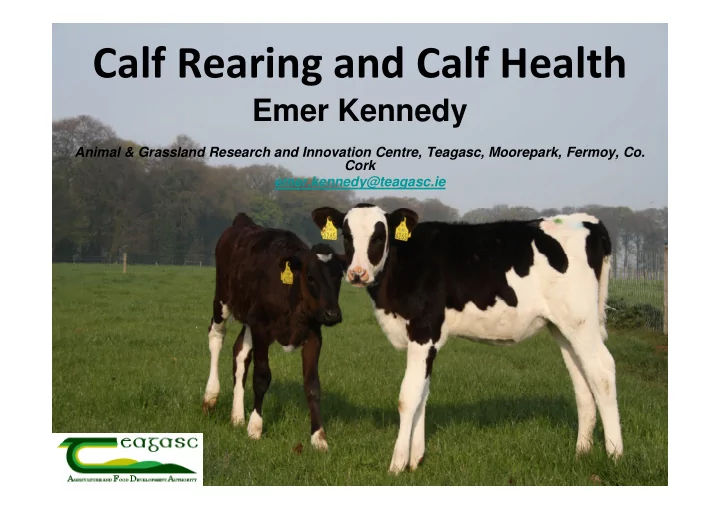

Calf Rearing and Calf Health Emer Kennedy Animal & Grassland Research and Innovation Centre, Teagasc, Moorepark, Fermoy, Co. Cork emer.kennedy@teagasc.ie
Calf Welfare – is there an issue? Calf mortality 7 6 • No calves dying in first 6 5 4 week reducing 3 2 1 • Low by international 0 standards Dead at birth, % Dead at 28 days, % Of samples tested: On-farm survey 9.6 % had FPT of IgG mg/ml Visit 1 31 immunity Visit 2 28 Mortality rate twice as Bulls 29 Heifers 30 high among FPT calves
On-farm survey: Volume fed to Calves No difference in Post Colostrum Milk feeding colostrum volume fed Bulls Heifers between bulls/heifer Waste Milk 34.04 17.02 Volume Percentage Whole milk + Waste 42.55 23.40 Milk < 2L 3 Milk Replacer 8.51 42.55 2-3 L 59 Whole milk 12.77 14.89 Yoghurt milk 2.13 2.13 3-4 L 17 Unknown 21 Bulls receiving 6 L /day Heifers 6.25 L /day OAD feeding on 38 % farms.. from 23 days.. 5 L/day 3
Environmental assessment Hygiene of feeding equipment • Influences transmission of disease ‘3M ™ Surface Hygiene Test Kit’ • Bacteria / Milk protein residue Four point scale • 1= Clean , 4 = High level of residue 4
Survey: Environmental assessment First visit: 2.29 Second visit: 2.76 Feeding Avg Hygiene Feeding Avg Hygiene implement score (1-4) implement score Group feeders 2.28 Group feeders 2.97 Automatic 1.00 Automatic 1.00 feeders feeders Bottle & teat 4.00 Bottle & teat 2.42 Individual 2.46 Individual 1.89 feeder feeder Stomach tube 4.00 Stomach tube 4.00 Young calves exposed to unhygienic equipment … 5
Achieving adequate passive transfer (APT) When a neonatal calf absorbs an adequate quantity of immunoglobulins 3 key factors for APT 1) Quality of colostrum 2) Timing of feeding 3) Volume of colostrum
The risks associated with poor colostrum management There are many negative consequences of failure of passive transfer (FPT) : • increased risk of disease and death, • slower growth rates • reduction in long-term productivity • decreased milk production in later life • increased culling rate during the first lactation • delayed time to first insemination 7
New Calf Born …… 1 am Go back to bed??? Feed Colostrum
Why is colostrum important? No transfer of immunoglobulins between cow and calf Placenta separates maternal and foetal blood supplies Calf is almost entirely dependent on absorption of maternal immunoglobulins from colostrum
Factors affecting colostrum quality (2) Time interval (1) Parity (3) Month of calving (4) Weight of colostrum IgG concentration decreased by 1.7 g/L per kg increase in the colostrum weight
Other Factors Affecting Colostrum Quality Lactation number Length of the non-lactating period (if less than 3 weeks) High ambient temperature pre-calving Breed of cow • Quality of colostrum in beef breeds is generally better than in dairy breeds • Average values in most studies well above 100 g/L - good enough to provide adequate passive transfer, as long as supervision is provided to ensure colostral intake 11
Changes in IgG content between milkings Colostrum Transition milk IgG g/L Milking number
Testing colostrum quality Look through eye piece What you see through the eye piece Place few drops of colostrum here Refractometer Values greater than 22% represent high quality colostrum suitable for calves 1 st feed
When should colostrum be fed? Within hours of birth
How soon should colostrum be fed? Maximum absorption within 2 hours Efficiency of IgG absorption (%) 50 40 30 20 10 0 0 6 12 18 24 Hours after birth
How much colostrum to feed? Feed at least litres
Pooling of colostrum • Pooling is not recommended • Pooling Risks – Dilution – Disease spread (Johne’s Disease)
Effect of colostrum origin on antibody absorption Treatment Own dam Other dam Pooled SEM P-value 88.55 a 94.18 b 87.41 a 1.66 <0.01 Colostrum IgG (mg/ml) 44.53 a 43.84 a 40.50 b 0.64 <0.01 24 h serum IgG (mg/ml) 55.39 a 54.07 a 51.52 b 0.76 <0.01 AEA* (%) *AEA is apparent efficiency of absorption 18
Colostrum storage Colostrum should be collected & stored in clean containers Refrigerate within 6 hours of collection Bacterial growth highest in first 6 hours Will last for 48 hours when refrigerated Colostrum can be frozen for up to a year Comparison of serum IgG concentrations between colostrum with varying bacteria levels 50 40 Serum IgG 30 20 10 0 Past Fresh 4 deg 13 deg 22 deg Treatment
Recommend
More recommend